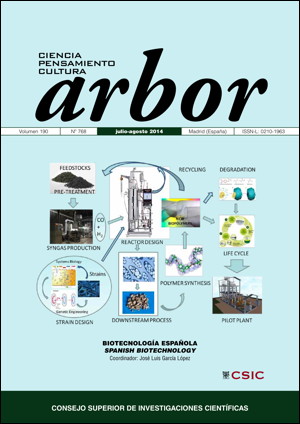Esteganografía lingüística en lengua española basada en modelo N-gram y ley de Zipf
DOI:
https://doi.org/10.3989/arbor.2014.768n4014Palabras clave:
Esteganografía lingüística, generación automática de estegotextos, N-Gram, algoritmoResumen
La esteganografía lingüistica es una ciencia que se aprovecha de la lingüistica computacional para diseñar sistemas útiles en la protección y la privacidad de las comunicaciones digitales y en el marcado digital de textos. En los últimos años se han documentado múltiples formas de alcanzar este objetivo. En este artículo se analiza la posibilidad de generar automáticamente textos en lenguaje natural en lengua española que oculten una información dada. Se proponen una serie de hipótesis y se experimenta mediante la implementación de un algoritmo. Las pruebas realizadas indican que es factible utilizar modelos N-Gram y peculiaridades derivadas de la ley de Zipf para generar estegotextos con una calidad lingüistica tal que un lector humano podría no diferenciarlo de otro texto auténtico. Los estegotextos obtenidos permitirán la ocultación de al menos 0,5 bits por palabra generada.
Descargas
Citas
Bergmair, R. (2007). A comprehensive bibliography of linguistic steganography. Proceedings of the SPIE International Conference on Security, Steganography, and Watermarking of Multimedia Contents. http://dx.doi.org/10.1117/12.711325
Blasco, J., Hernández-Castro, J., Tapiador, J. y Ribagorda, A. (2008). Csteg: Talking in C code. Proceedings of SECRYPT International Conference, pp. 399–406.
Chand, V. y Orgun, C. (2006). Exploiting linguistic features in lexical steganography: design and proofof-concept implementation. Proceedings of the 39th Annual Hawaii International Conference on System Sciences (HICSS '06), 6, p. 126b. http://dx.doi.org/10.1109/HICSS.2006.175
Chapman, M. y Davida, G. (1997). Hiding the hidden: A software system for concealing ciphertext as innocuous text. Proceedings of the International Conference on Information and Communication Security. Lecture Notes in Computer Sciences, 1334. http://dx.doi.org/10.1007/BFb0028489
Chapman, M., Davida, G. y Rennhard, M. (2001). A practical and effective approach to large-scale automated linguistic steganography. ISC '01 Proceedings of the 4th International Conference on Information Security, pp. 156-165.
Chomsky, N. (1965). Aspects of the theory of syntax. Cambridge, MA: MIT Press.
Cox, I., Miller, M., Bloom, J., Fridrich, J. y Kalker, T. (2007). Digital Watermarking and Steganography (2ª ed.). San Francisco: Morgan Kaufmann Publishers.
Dai, W., Yu, Y. y Deng, B. (2009). BinText steganography based on Markov state transferring probability. ICIS '09 Proceedings of the 2nd International Conference on Interaction Sciences: Information Technology, Culture and Human, New York: ACM, pp. 1306-1311.
Grothoff, C., Grothoff, K., Alkhutova, L., Stutsman, R. y Atallah, M. (2005). Translation-Based Steganography. Computer Science Information Hiding. Lecture Notes in Computer Science, 3727, pp. 219-233. http://dx.doi.org/10.1007/11558859_17
Kahn, D. (1996). The Codebreakers: The Comprehensive History of Secret Communication from Ancient Times to the Internet. New York: Scribner.
Kerckhoffs, A. (1883). La cryptographie militaire. Journal des sciences militaires, IX, pp. 5-38 y 161-191.
Meng, P., Hang, L., Yang, W., Chen, Z. y Zheng, H. (2009). Linguistic Steganography Detection Algorithm Using Statistical¡ Language Model. International Conference on Information Technology and Computer Science 2009 (ITCS 2009), pp. 540-543. http://dx.doi.org/10.1109/ITCS.2009.246
Meng, P., Liusheng, H., Zhili, C., Yuchong, H. y Yang, W. (2010). STBS: A Statistical Algorithm for Steganalysis of Translation-Based Steganography. Lecture Notes in Computer Science, 6387, pp. 208-220. http://dx.doi.org/10.1007/978-3-642-16435-4_16
Muñoz, A., Argüelles, I. y Carracedo, J. (2009). Modificaciones sintácticas en lengua espa-ola con utilidad en esteganografía lingüistica. Revista Electrónica de Lingüistica Aplicada, 8, pp. 229-247.
Muñoz, A. y Argüelles, I. (2012). Modificaciones sintácticas basadas en la reordenación de complementos del verbo con utilidad en esteganografía lingüistica. Revista Electrónica de Lingüistica Aplicada, 10, pp. 31-54.
Shu-feng, W. y Huang, L. (2003). Research on Information Hiding. Degree of master, University of Science and Technology of China.
Topkara, M. Topkara, U. y Atallah, M. (2007). Information Hiding through Errors: A Confusing Approach. Proceedings of the SPIE International Conference on Security, Steganography, and Watermarking of Multimedia Contents, 29. http://dx.doi.org/10.1117/12.706980
Wayner, P. (1992). Mimic functions. Cryptologia, XVI, pp. 193–214. http://dx.doi.org/10.1080/0161-119291866883
Wayner, P. (1995). Strong theoretical steganography. Cryptologia, XIX, pp. 285–299. http://dx.doi.org/10.1080/0161-119591883962 http://dx.doi.org/10.1080/0161-119591883962
Zuxu, D., Fan, H., Muxiang, Y. y Guohua, C. (2007). Text Information Hiding Based on Part of Speech Grammar. Proceedings of the 2007 International Conference on Computational Intelligence and Security Workshops (CISW 2007), pp. 632-635. http://dx.doi.org/10.1109/CISW.2007.4425575
Publicado
Cómo citar
Número
Sección
Licencia
Derechos de autor 2014 Consejo Superior de Investigaciones Científicas (CSIC)

Esta obra está bajo una licencia internacional Creative Commons Atribución 4.0.
© CSIC. Los originales publicados en las ediciones impresa y electrónica de esta Revista son propiedad del Consejo Superior de Investigaciones Científicas, siendo necesario citar la procedencia en cualquier reproducción parcial o total.
Salvo indicación contraria, todos los contenidos de la edición electrónica se distribuyen bajo una licencia de uso y distribución “Creative Commons Reconocimiento 4.0 Internacional ” (CC BY 4.0). Consulte la versión informativa y el texto legal de la licencia. Esta circunstancia ha de hacerse constar expresamente de esta forma cuando sea necesario.
No se autoriza el depósito en repositorios, páginas web personales o similares de cualquier otra versión distinta a la publicada por el editor.














